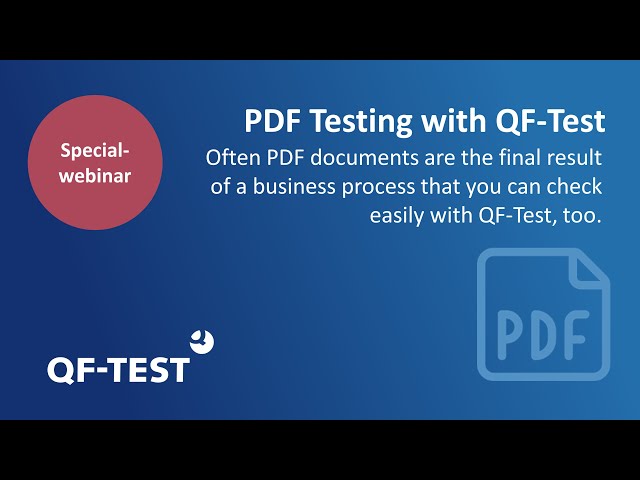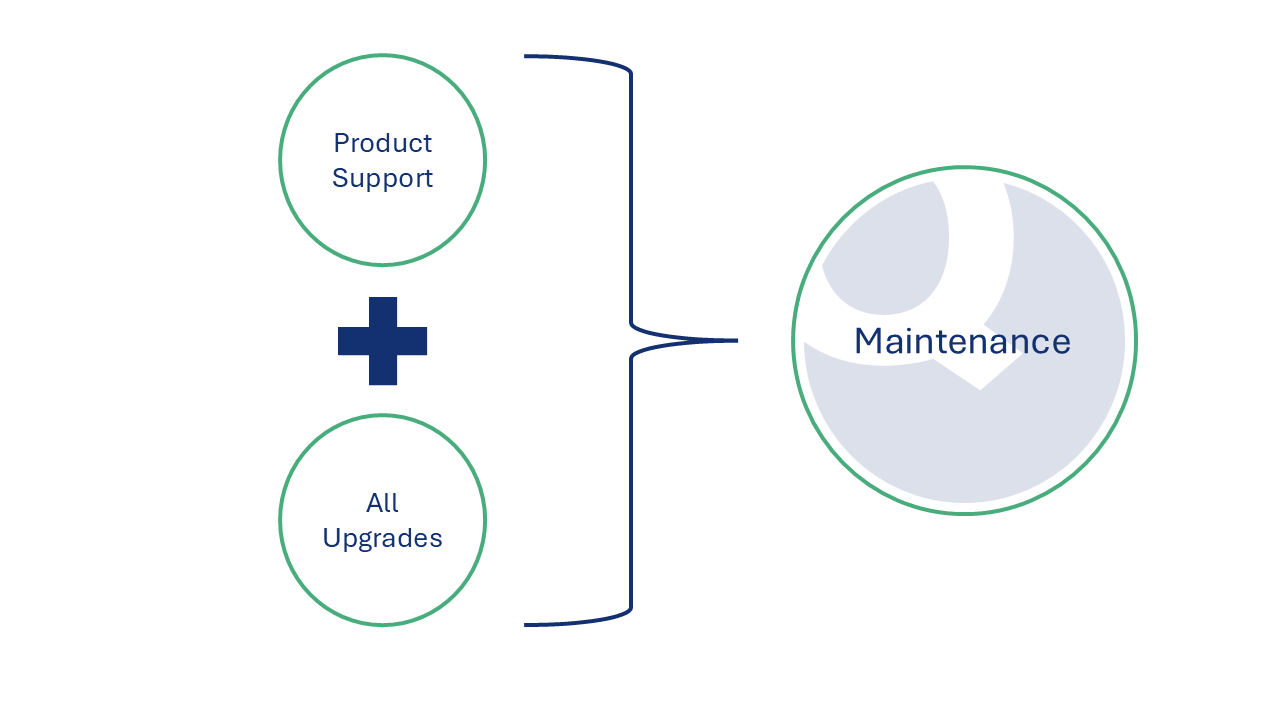Send us a description of the issue via email to support@qftest.com and we will have a look. Please make sure to provide as much information as possible, especially test suites and run logs.
In addition to the following general FAQs, answers to technical questions can be found in the QF-Test manual.
Feature requests and bug reports
Where can I report a bug in QF-Test
Simply send us an email
How can I suggest features (Feature requests) for QF-Test?
Feature requests are always welcome
Please send your ideas and wishes to support@qftest.com.
Support and Training
Are there any free offerings?
Sure! Here is a list of our free offerings
- Free Trial of QF-Test
- Free Special Webinars
- YouTube Videos
- Tutorial
- Manual
- Blog
- During Evaluation: Free Starter Webinar
What about consulting for QF-Test?
We offer consulting and often combine this with a workshop
What about training for QF-Test?
QF-Test training for beginners and advanced users in German and English takes place regularly
Where can I get help troubleshooting?
Please read this FAQ to see if your question has already been answered. If not please read on.
- Additional information can be found in the technical FAQ.
- Get started: For when you’re having trouble installing and licensing QF-Test.
- Interactive tutorial: For getting started with QF-Test quickly (especially note the chapter Getting help).
- Manual: All further questions should be answered by our comprehensive manual.
- Context sensitive help: click the right mouse button on pretty much any part of the QF-Test UI and select “What’s this?” to jump to the corresponding manual page.
- Videos: Check out our growing library of videos about various subjects for beginners and advanced users.
- Blog: We sometimes share helpful tips and tricks for using QF-Test on our blog.
- Free email support: During your evaluation period of QF-Test we grant free support. This channel, including guaranteed response time, is also available to customers with a maintenance contract.
Licenses
I have received a license file as attachment of an email. What shall I do with it?
To answer this question, we have written a dedicated blog article
When do I need a license server?
You need a license server when you want to use your floating licenses across multiple sites or in restricted networks.
QF-Test handles multi user license management for local networks by itself, provided that IP multicast works.
More info in the product description and technical details in the license server manual.
Evaluation
What is the best way to get started with QF-Test?
Download the trial version without registration and request a trial license now.
And where do I get this license file?
You can request a free trial license valid for 4 weeks
Request it using the trial request form. With this license you can evaluate QF-Test for your application without restrictions.
Is a trial version available for download?
Yes. You can download the trial version without registration.
Get QF-Test on our Download page. You can start your application with QF-Test and get a first impression of the tool and to check out the tutorials. To save your work you’ll need a license.
Why UI test automation?
My boss doesn’t want to spend any money! What can I tell him/her?
Thanks to the great usablity of QF-Test, testers can get off the ground quickly and efficiently. Combined with the low licensing fees, you can expect a quick return on investment
Just compare the cost of QF-Test licenses with the cost of developers’ or testers’ wages and the cost of bugs detected after release – not to mention the damage to your company’s reputation.
If your boss is still on the fence, you can send them a link to our page Benefits for decision-makers.
What’s the point of test automation?
Automated software testing reduces the time and money spent on quality assurance
Comprehensive automated tests, executed regularly during software development, will help to find bugs at an early stage. The reproducible security achieved this way ensures higher quality and shorter time to market at lower maintenance expense.
I already do unit testing, why is that not enough?
Though indispensable, unit tests can only test small parts of a system in isolation (“steering wheel OK, motor OK”)
GUI based testing exercises an application as a whole, because a working steering wheel and motor in isolation don’t guarantee roadworthiness. For more, see our page Benefits for developers.
General questions
What are SmartIDs?
SmartID is a technology first introduced in QF-Test 6.0. With it, referencing your application’s components in QF-Test becomes much simpler than before
Instead of recording a component and referencing it via its “QF-Test ID”, with a SmartID you can reference the GUI-Element directy by its properties. For example, the SmartID ”#Button:label=OK” references a button with the label “OK”.
Thanks to this technology it becomes possible to reference components much more precisely and intuitively, regardless of the SUT.
SmartID – The next generation of component recognition
We are always working on improving component recognition in QF-Test. With QF-Test 6.0 we introduced a completely new paradigm: SmartID
Is QF-Test a low-code/no-code tool?
Yes! QF-Test is designed as low-code software so that you can develop, run and maintain your tests without programming knowledge using “capture and replay”.
However, experienced developers can also interact with QF-Test and your SUT at the script level at any time to develop even more powerful automations.
How much does QF-Test cost?
License types and prices for QF-Test are listed on our Prices page
You can choose between purchasing a persistent license or a subscription license. All QF-Test licenses are “floating” within a network.
Who is using QF-Test?
More than 1,400 companies in over 60 countries rely on QF-Test. More than 8,500 licenses are in use from small companies up to the largest IT service providers
For examples, see our References page.
Can QF-Test be integrated with other tools?
Yes. QF-Test offers flexible integration with other tools. It uses XML as primary data format and offers multiple interfaces: batch execution via command line, daemon mode, scripting, REST, and XML reporting. This enables integrations in the following areas
- Continuous Integration and build tools such as Jenkins, GitLab CI/CD, Bamboo, Travis CI, Circle CI, TeamCity, Ant, Maven, CruiseControl
- Robot Framework: QF-Test procedures can easily be used as keywords
- Virtual desktops such as Citrix, VMware, VirtualBox
- Version control such as Git, SVN/Subversion, CVS, Mercurial
- Test management tools such as ALM/QualityCenter by MicroFocus/HP, TestBench by Imbus, QMetry, TestLink, IBM Rational Quality Manager
- JIRA and JIRA Plugins like TestRail, Zephyr, X-Ray, TM4J
- Keyword-driven/behavior-driven testing via our own approaches, Test management tools, Excel, Cucumber
- Data-driven Testing with Excel, CSV and all kinds of databases
- Error tracking with tools like Jira, MantisBT, and Bugzilla
- Load and performance tests via daemon mode or tools like NeoLoad
Which Java versions are supported by QF-Test ?
QF-Test is distributed with OpenJDK version 17
Applications under test may use any version of Java 8 or newer.
Which platforms is QF-Test available for? (System requirements)
QF-Test supports the following operating systems
- Windows (Windows 11, Windows 10, Server 2022, Server 2019 and Server 2016): Test Java Swing, SWT, JavaFX, Web, Android and native Windows applications with QF-Test.
- Linux(Solaris, AIX, HP-UX, etc.): Test Java Swing, SWT, JavaFX, Android and Web applications with QF-Test.
- macOS: Test Java Swing, JavaFX, Android, iOS and Web applications with QF-Test.
Read more about support for specific JDK/SWT/Browser versions in the “Installation” chapter of the manual.
Why should I choose QF-Test?
Easy question: QF-Test is easy to use, highly flexible, powerful, and extensively documented
Easy to use
- Quickly create tests with capture and replay
- Easily find your way through QF-Test’s intuitive GUI
- No programming skills required: Compose complex, high-coverage tests with our tree interface.
Highly flexible
- QF-Test automatically adapts to changes in the UI of the application under test
- Intelligent recording and filtering
- Full access to recorded sequences
- Support for trees, tables and other widgets – even with dynamic content
Powerful
- Powerful algorithms for component recognition
- Optional advanced programming elements like loop constructs, ‘try/catch’, dependencies, and logical ‘if/else’ control structures, as well as variables and procedures for building modularized tests
- Text processing with regular expressions
- Full access to the Java API of the application under test
- Integrated scripting with Jython, Groovy and JavaScript
- XML/HTML based test reporting, including screenshots
- Command line batch processing
Well-documented
- Ships with an extensive manual (over 1,000 pages) including a user guide with many examples and a technical reference section
- The Tutorial assists you with getting started quickly, with many easy to understand test scenarios
- Includes dozens of example test suites
- Access our growing collection of video tutorials and workshops
- We share many tips and tricks on our Blog
- All our documentation and support resources are available in english and german
For detailed information on QF-Test versions, please refer to the releases page.
What GUI technologies can be tested with QF-Test?
QF-Test supports the following UI Frameworks and platforms
Java applications
- All kind of Java applications can be tested.
- Everything is covered from the traditional Swing (including Webstart, ULC, JIDE components, CaptainCasa), and its successor JavaFX and also SWT, the Standard Widget Toolkit from Eclipse, including Plugins and RCP (Rich Client Platform) applications.
Hybrid applications
Use QF-Test to test applications combining Java and Web using technologies like JxBrowser, SWT-Browser, JavaFX WebView components, but also Java In Browser applications using JPro or Webswing.
Web applications
- QF-Test provides cross-browser testing of Web GUIs and Electron applications.
- QF-Test completely supports reactive frameworks like Angular, React and Vue.js. Support for many dedicated UI component libraries comes integrated in QF-Test, like SmartGWT, ExtGWT, ExtJS, ICEfaces, jQuery UI, jQueryEasyUI, Kendo UI, PrimeFaces, Qooxdoo, RAP, RichFaces, Vaadin and ZK. Other toolkits like SAP UI5, Siebel Open UI, and Salesforce can be integrated with little effort. Our support team is ready and able to assist you.
- QF-Test supports all common browsers (Google Chrome, Mozilla Firefox, Opera, Safari and Microsoft Edge) as well as the headless versions of Chrome, Firefox and Edge (Chromium based)
Progressive Web Applications
Mobile websites and web applications are testable via the dedicated mobile emulation mode.
Mobile applications
Android and iOS applications with support of both real devices and the Android Studio emulator
Native Windows applications
QF-Test supports native Windows desktop applications built with Win32, .Net (often written in C#), Windows Forms, WPF, Windows Apps, and Qt (often written in C++)
PDF documents
PDF documents can also be tested by QF-Test. See our introduction video to testing PDF documents:

PDF Testing with QF-Test
Often PDF documents are the final result of a business process that you can check easily with QF-Test, too.
What is QF-Test?
QF-Test is a software tool for creating, executing and administrating automated GUI tests for Web, Java, Windows, Android and iOS applications
We – Quality First Software (QFS) – have been the independent developer and distributor behind QF-Test since 2001. Detailed information about QF-Test is available on our product page.
Maintenance contracts

How can I extend my QF-Test maintenance contract?
Would you to renew your maintenance contract, support contract or license agreement?
When can I use the latest QF Test version?
Your QF-Test license knows your maintenance period and you can always download and use the latest version from our homepage…
What do the version numbers mean e.g. QF-Test Version 7.1.2?
The QF-Test version numbers consist of three parts, major~, medium~ and minor version.
QF-Test licenses are generally valid for all minor versions within the same major.medium version, plus all older QF-Test versions.
- Minor upgrades are free of charge
- Major and Medium upgrades are liable to costs or included in the maintenance contract.
If you have an old QF-Test version and want to upgrade it, please contact us directly.
Major upgrade
A major upgrade refers to the “first” version number, e.g. from 6.4.3 to 7.0.0.
Medium upgrade
Amediumupgrade refers to the version number in the “middle” , e.g. from 7.0.0 to 7.1.0.
Minor upgrade
Minor upgrades (=Updates) e.g. from 7.0.1 to 7.0.2 are in general free of charge as they mainly contain bug fixes and are part of the product warranty.
What is included in the maintenance contract?
When purchasing the maintenance contract you have access to our professional support team and all new versions of our software…
Your license knows your maintenance period and gives you permission to use the latest software version downloaded from our homepage.

Purchasing QF-Test
Can I run remote tests?
Yes of course…
You can run several automated tests in different environments and platforms remotely.
When do I need a license server?
You need a license server when you want to use your floating licenses across multiple sites or in restricted networks.
QF-Test handles multi user license management for local networks by itself, provided that IP multicast works.
More info in the product description and technical details in the license server manual.
Which GUI technology/technologies do I need? Java Swing, SWT, JavaFX, Windows, Web, Android, iOS?
QF-Test licenses can be purchased specifically for the GUI technologies actually needed. In order to determine the GUI technologies for your application,…
open your test-suite(s) and run all your client(s) via QF-Test. After having executed your tests, please open the ‘Clients’ menu. There you can see the GUI technologies used in [] brackets. In the example there are two clients running using [Swing] and [Web]; all combinations out of [Swing], [Swt], [FX], [Web], [Win] and [Android / iOS] are possible.
Alternatively contact our Sales team: +49 8171 38648-0 or sales@qftest.com.
What is the difference between purchase and subscription licensing?
Purchase: You purchase the licenses (permanent) once and only renew the maintenance contract yearly…
Subscription licensing: You subscribe for the required period. This price includes software maintenance and support.
When do I need a developer and when a runtime license?
With a developer license you can create tests and during the time you don’t develop new tests, you can use the license for test execution…
With a runtime license you can execute tests (even remotely and via command line in batch mode). You can even do short-term changes (“fast debugging”), which however cannot be saved, since the runtime license is meant for executing tests.
 Max Melzer
Max Melzer